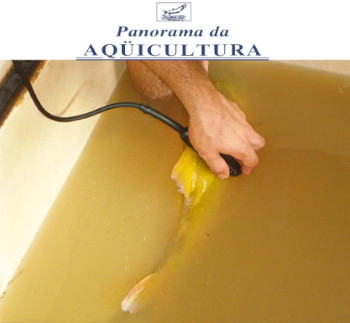|

Image: Panorama da Aqüicultura / FIS
Application of ultrasonography in tambaqui breeding programs
 BRAZIL
BRAZIL
Monday, May 01, 2023, 09:00 (GMT + 9)
The following is an extract from an article published by Panorama da Aquicultura:
The use of ultrasound in recent decades in domestic animals has focused on veterinary diagnostics and reproductive evaluations in animals of interest in livestock. In aquaculture, ultrasound is still little explored, with studies focused on reproductive evaluations of fish. The use of this methodology is gradually gaining space in aquaculture for measuring phenotypes of interest for genetic improvement programs. Researchers from the University of Mogi das Cruzes and the Instituto Nacional de Pesquisas da Amazônia have been developing this technology for its application in the genetic improvement of tambaqui.

Photo: Panorama da Aqüicultura
The human hearing system is incapable of capturing very low sound frequencies (infrasound, below 20 Hz) or very high frequencies (ultrasound, above 20 kHz). However, it is known that the sound waves produced when they come into contact with obstacles can reverberate/reflect or even overcome this barrier and expand to other environments. In this way, the ultrasound technique basically consists of reading the echoes produced by the reflections of sounds above 20 kHz along the path it travels. For this purpose, ultrasound devices have the ability to emit mechanical waves (sound) generated by the vibration of a piezoelectric crystal. Thus, the ultrasound pulse generated by the equipment has the ability to reflect bodily structures that, upon returning to the device, are transformed into electrical pulses that, in turn, are displayed on a monitor. To better understand, the sound waves emitted by the ultrasound can be absorbed by soft tissues (muscles or fat) and reflect the sound pulses that are visualized with less intense images in the equipment.
.jpg) (A and C) Scheme of the bone structure of fish and different shapes of intramuscular spines (sources: (A) Patterson and Johnson, (1995). Smithsonian. Contribution to Zoology 559, 1-85; Dowgiałło, (2005). (C) ) Electronic Journal of Polish Agricultural Universities 8(2), #20); (B) Tambaqui with approximately 2 cm in total length processed by the clearing technique and (D) Intramuscular spines with a “Y” shape visualized in the cleared fish. Source: Panorama da Aqüicultura--> (A and C) Scheme of the bone structure of fish and different shapes of intramuscular spines (sources: (A) Patterson and Johnson, (1995). Smithsonian. Contribution to Zoology 559, 1-85; Dowgiałło, (2005). (C) ) Electronic Journal of Polish Agricultural Universities 8(2), #20); (B) Tambaqui with approximately 2 cm in total length processed by the clearing technique and (D) Intramuscular spines with a “Y” shape visualized in the cleared fish. Source: Panorama da Aqüicultura-->
In the case of bone structures (hard tissue) these phenomena occur differently, generating images with more intense and clear brightness. The image resolution depends on the frequencies of the sound waves generated by the equipment. In this way, high frequencies (shorter wavelengths – between 2.5 and 3.0 MHz) produce a better resolution of the generated images, allowing us to observe in more detail the region of the body that is being investigated.
Ultrasonography applied in diagnostics in medicine has its origins in the 1940s, when the ultrasound technique was used in neuropsychiatry by Karl Theodore Dussik, at the University of Vienna. Since then, the use of ultrasound has grown dramatically for diagnoses in human health. In the following decades, there were the first records of the use of ultrasound in domestic animals to measure the thickness of the loin in cattle and to evaluate the carcass in pigs (1956), as well as for the diagnosis of pregnancy in goats (1966). Since then, the technological improvement of ultrasound equipment designed specifically for domestic animals has made this methodology essential, both for genetic improvement programs and for veterinary diagnostics.

<--Images obtained using an ultrasound device in a longitudinal section of a tambaqui in which (A) has intramuscular spines and (B) does not have “Y” spines; cross section (C) intramuscular pimples indicated in yellow and (D) absence of intramuscular pimples. Source: Panorama da Aqüicultura.
In aquaculture, the use of ultrasound is still very little explored. The works published with ultrasound in fish research have focused on the reproduction area for sex determination in species without sexual dimorphism, as well as on the evaluation of the gonadal maturation stage to verify the reproductive conditions of females. The use of ultrasonography to measure phenotypes of zootechnical interest in aquaculture species has had little record in the scientific literature. Some of these works used ultrasound images to predict meat yield in American catfish (Ictalurus punctatus) in live animals, which makes it possible to use the data to improve efficiency in selection programs. The same approach has also been used for rainbow trout (Oncorhynchus mykiss) and surubim (Pseudoplatystoma corruscans). [Continues...]
Authors: Alexandre W.S. Hilsdorf | Cayo Augusto Perazza | Vera María F. de Almeida-Val | Panorama da Aqüicultura | Read the complete article by clicking on the link here (only available in Portuguese)
[email protected]
www.seafood.media
|



